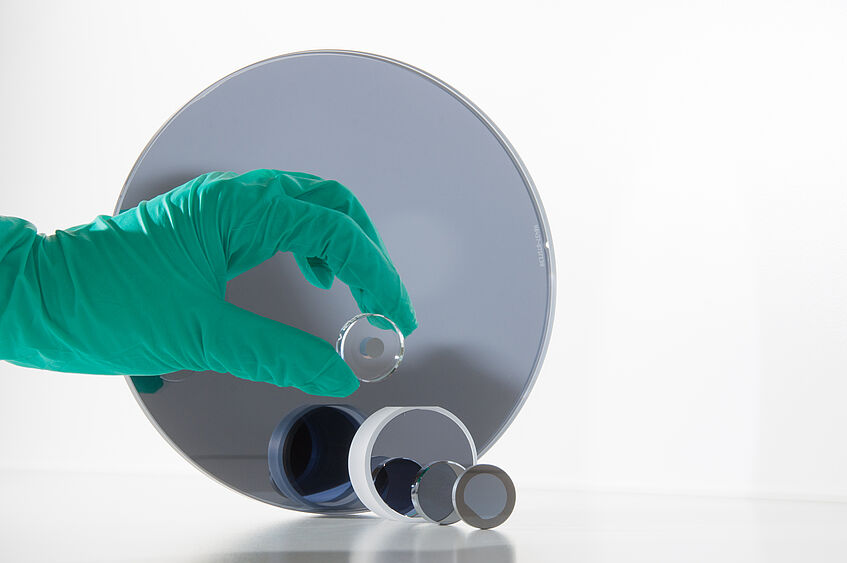VDSP Science Day - Abstracts
Crystalline Supermirrors for Infrared Applications

@ Georg Winkler, University of Vienna
Crystalline Supermirrors for Infrared Applications
Lukas Perner
Supervisor: Oliver Heckl
High-performance supermirrors are employed in a variety of applications in optics and photonics: They are a key element for stable optical cavities, which are routinely used to narrow the linewidth of continuous-wave lasers, thereby creating optical references for frequency comb stabilization and precision spectroscopy. Furthermore, they are a vital component for optical interferometers, which enable scientific discovery in fields as seemingly unrelated as microcavity sensing and gravitational wave detection.
Especially at mid-infrared wavelengths, emerging applications in chemical sensing, discrete imaging, ultracold chemistry, and even fundamental physics will benefit immediately from high-performance mirrors. Therefore, the development of low-loss mirrors in this wavelength range is a long-standing goal. However, traditional techniques for the fabrication of high-reflectivity mirrors fail to match the performance readily accessible in the visible and near-infrared wavelength range.
In recent years, substrate-transferred monocrystalline supermirrors have emerged as a promising technology to overcome these limitations. Originally developed as a means to overcome the Brownian-noise limit in precision near-infrared interferometry, crystalline mirrors also exhibit extremely low absorption and scatter losses over their entire transparency window (0.87 µm to 10 µm). This enables supermirror-level reflectivity at mid-infrared wavelengths.
In this highlight talk we will take a look at the key features and wide range of applications of these crystalline Bragg reflector mirrors. Building on this framework, I will also present our achievements in precision characterization and design improvements, including the recent demonstration of unprecedentedly high-reflectivity mirrors at 4.45 µm. Finally, I will give an outlook on ongoing and future efforts.
Indirect measurement of the carbon adatom migration barrier on graphene
Andreas Postl et al.
Supervisor: Toma Susi
Although surface diffusion is crucial for many physical and chemical processes, including the epitaxial growth of crystals and heterogeneous catalysis, it is particularly challenging to study directly. We estimated the carbon adatom migration barrier on freestanding monolayer graphene by quantifying its temperature- dependent electron knock-on damage [1]. Heating of monolayer graphene remarkably increases its radiation hardness to energetic electrons [2, 3]. We provided a quantitative explanation for this by analyzing and modeling the observed damage rates and counteracting vacancy healing by diffusing adatoms at 300–1073 K. By taking into account the finite probe of our scanning transmission electron microscope, we found a barrier of (0.33 ± 0.03) eV, which agrees well with theoretical predictions [4, 5].
[1] Postl et al., Carbon 196 (2022) 596-601. doi:10.1016/j.carbon.2022.05.039.
[2] Song et al., Nano Letters 11 (6) (2011) 2247–2250. doi:10.1021/nl200369r.
[3] Zan et al., Nano Letters 12 (8) (2012) 3936–3940. doi:10.1021/nl300985q.
[4] Krasheninnikov et al., Physical Review B 69 (2004) 073402. doi:10.1103/PhysRevB.69.073402.
[5] Lehtinen et al., Physical Review Letters 91 (2003) 017202. doi:10.1103/PhysRevLett.91.017202.
Andreas Postl1,2, Pit Pascal Patrick Hilgert1, Alexander Markevich1, Jacob Madsen1,
Kimmo Mustonen1, Jani Kotakoski1, Toma Susi1
1 University of Vienna, Faculty of Physics, Boltzmanngasse 5, A-1090, Vienna
2 University of Vienna, Vienna Doctoral School in Physics, Boltzmanngasse 5, A-1090, Vienna
Rising speed limits for fluxons via edge quality improvement in wide MoSi thin films
Barbora Budinska
Supervisor: Oleksandr Dobrovolskiy
The movement of supercurrent vortices (fluxons) in type II superconductors causes dissipation of energy, destroying their zero-resistivity state, which is the property of superconductors that makes them so unique and of great technological importance. So, one might ask, why are we trying to achieve high vortex velocities and invest energy in studying the dynamics of these topological objects when most researchers try to restrict their movement via pinning? In this talk, I will address a variety of applications and physical phenomena that are connected to vortex dynamics, and we will take a closer look at the recent discovery of edge importance to the research field.
Multipolar Magnetism - the effect of spin orbit coupling in materials
Dario Fiore Mosca
Supervisor: Cesare Franchini
Recent years have seen a growing interest in materials with strong spin-orbit coupling effect, where exotic quantum states of matter can be realized. In transition metal oxides containing 5d ions, spin-orbit coupling can be as large as half of an eV, making the spin and orbital angular momentum not good quantum numbers anymore. New large spin-orbital entangled quantities are formed and described by the total angular momentum J. The interaction between these spin-orbital moments (multipolar interactions), in cooperation with crystal field and electron correlation, can realize ground states with tilted magnetic moments or with hidden order parameters where higher than magnetic dipoles order magnetically (magnetic multipolar order). The focus of my work is in deciphering the role of multipolar magnetism in materials with electronic configuration 5d1 and 5d2.
Aerosol Nanoplastics – Generation, Size Characterization, and Activation
Peter Wlasits
Supervisor: Paul Winkler
Mass production of plastic products has led to an environmental problem on global scale. Nanoplastics, i. e. plastic particles with diameters smaller than one micrometer, have been found in sparsely populated areas far away from metropolitan regions. Such discoveries emphasize the relevance of atmospheric transport processes of airborne nanoplastic particles. Despite growing research interest, knowledge about pathways into the environment is scarce. The first step towards a deeper understanding of the physical and chemical properties of aerosol nanoparticles from plastics consists of characterizing potential generation mechanisms and the introduction of a plastic nanoparticle standard. Such a nanoplastics standard not only facilitates research on interactions of plastic particles with water vapor in the atmosphere, but also enables research on toxicological effects. My research focuses on the reproducible generation and characterization of nanoplastic particles and their activation in water vapor.
